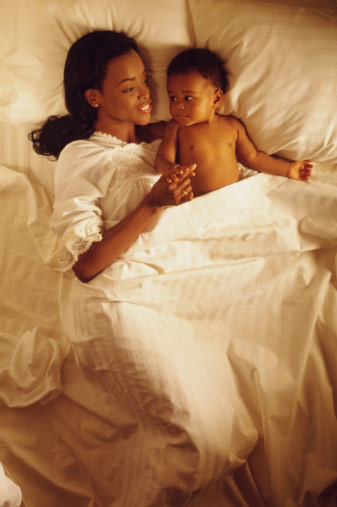December 08 2009
 According to Dr. Jay Gordon, babies sleeping on a safe surface with sober, nonsmoking parents respond to their parents, and the parents respond to them. The chance of SIDS occurring in this situation are close to zero. Babies in a crib or in a room away from their parents, on the other hand, will breastfeed less and are at greater risk of infections, including life-threatening ones.
According to Dr. Jay Gordon, babies sleeping on a safe surface with sober, nonsmoking parents respond to their parents, and the parents respond to them. The chance of SIDS occurring in this situation are close to zero. Babies in a crib or in a room away from their parents, on the other hand, will breastfeed less and are at greater risk of infections, including life-threatening ones.
The medical profession, as it often does, is approaching the entire idea of the family bed backward. A baby in the same bed with his or her parents is surrounded by the best possible surveillance and safety system. It must be the responsibility of the manufacturers and proponents of cribs and separated sleep to prove that such disruption is safe, not the other way around.
Newborn babies breathe in irregular rhythms and even stop breathing for a few seconds at a time. To put it simply, they are not designed to sleep alone.
Sources:
| | |
Back in 2002, the Consumer Product Safety Commission (CPSC) and the Juvenile Product Manufacturers Association (JPMA, the crib manufacturers' lobby) launched a campaign to discourage parents from sleeping with their infants.
They also warned about allowing babies to sleep alone in adult beds.
Both warnings were based on data that, presumably, showed infants had a small risk of dying in adult beds.
The Dangers Infants Face When Sleeping in an Adult Bed
For example, an article in the Archives of Pediatric and Adolescent Medicine stated that, based on records from the CPSC dating from January 1990 to December 1997, there were a total of 515 deaths of children younger than 2 years who were placed to sleep on adult beds.
Of those, 121 were caused by a parent or sibling lying on top of the child, and 394 were due to entrapment in the bed structure, causing suffocation or strangulation.
In conclusion, the authors stated:
“Placing children younger than 2 years to sleep in adult beds exposes them to potentially fatal hazards that are generally not recognized by the parent or caregiver.
These hazards include overlying by a parent, sibling, or other adult sharing the bed; entrapment or wedging of the child between the mattress and another object; head entrapment in bed railings; and suffocation on waterbeds.”
However, the recommendation to avoid co-sleeping with your infant has been heavily criticized by many child health experts who believe bedsharing is the healthiest alternative.
And some who have taken the time to review the data further have come to an entirely different conclusion than the CPSC, raising the question whether perhaps this recommendation was more about benefitting the juvenile products industry than promoting the safest sleeping habits.
Statistics Show Co-Sleeping is Likely Twice as Safe as Sleeping in a Crib!
In an article for Mothering magazine, Tina Kimmel dissected the statistics from an 18 year period (1980-1997), showing how co-sleeping with your infant may actually be twice as safe as letting them sleep alone in a crib.
Interestingly, the CPSC never actually presented the relative risk of each sleeping scenario, which may lead parents to think that letting their child sleep alongside them is the more dangerous alternative.
However, when the relative risk of each is assessed by dividing the measure of danger for each situation by the prevalence of that situation, and then comparing them, it turns out that infants are more than twice as safe in adult beds as in cribs.
In fact, using the CPSC’s own data for measuring the danger of each situation, and data from the CDC's Pregnancy Risk Assessment Monitoring System (PRAMS) to ascertain the prevalence or frequency of each sleeping scenario, Kimmel found that crib sleeping had a relative risk of 2.37, compared with sleeping in an adult bed.
Clearly, looking at the relative risk of each situation makes more sense than basing your decision on an arbitrary assumption that bedsharing is dangerous. Especially since it’s not necessarily true.
Bedsharing May Be a Safer Option for Breastfed Infants
Interestingly, in one British study, breastfeeding mothers who shared their bed with their infants were found to sleep in a characteristic manner that promotes safety for the child, whereas mothers who bottle-fed their babies did not.
The researchers explained:
“The mother spontaneously adopted a distinctive lateral position facing the infant, with her knees drawn up under the infant's feet and her upper arm positioned above the infant's head. This position facilitates the baby's easy access to mother's breasts, and babies orient themselves towards their mother's breasts for most of the night.
It also provides several safety benefits:
the baby is flat on the mattress, away from pillows
the baby is constrained by the mother's knees and arm so that it can't move up or down the bed
the mother controls the height of bed covers over the baby
it is very difficult for the baby to be rolled on by either parent, as the mother's elbow and knees are in the way
the mother is close enough to monitor the baby's temperature and breathing continually ·
Bedsharing families who did not breastfeed slept together differently, particularly with respect to the physical orientation to the infant.
Mothers who had never breastfed did not curl up around their infants for sleep and did not, therefore, use their own bodies to make a constrained space in the bed for the baby.
These mothers primarily positioned their infants at face height in the bed, either between or propped up on the parents' pillows. Mothers also spent a much smaller proportion of the night facing their infants, and although infants were still oriented towards their mothers for the majority of the night, the mother's position meant there was less face-to-face orientation.
It seems that the mothers who didn't breastfeed slept with their infants as if they were sleeping with another adult (faces at same height, no protective sleeping position, less persistent orientation towards infant).”
Safe Bedsharing Guidelines
Naturally, no single sleeping arrangement is 100 percent safe as there are many factors that can play a role. For example, as the study above discovered, whether or not you breastfeed your child may influence the instinctive positioning of your baby in relation to yourself, making bedsharing more or less safe.
Alcohol consumption and whether or not you smoke would also be factors to take into consideration. But overall, according to the research of James McKenna, Director of the University of Notre Dame's Mother-Baby Sleep Laboratory, infant deaths are far more common in cribs than in beds shared with parents.
The single most dangerous thing you can do is to leave your child alone during sleep, he says.
There are a number of studies, several of which are discussed in McKenna’s paper “Why babies should never sleep alone: A review of the co-sleeping controversy in relation to SIDS, bedsharing and breastfeeding,” that show bedsharing, or sleeping in close proximity, actually protects against SIDS rather than cause it.
That said, there are certain common sense guidelines to keep in mind if you decide that bedsharing is right for you and your child.
Safebedsharing.org offers these sensible safety guidelines:
Never leave an infant or toddler unattended on an adult bed. Co-sleeping or family bed sharing consists of an adult and a child. Babies can roll off of beds (even when using a co-sleeping device), can become tangled in blankets, or otherwise need the attention of an adult. We recommend babies not be left unattended in the early months.
Never sleep with your baby on a water bed or on a couch. Water beds and couches are associated with suffocation of babies.
Avoid adding railings or putting furniture next to the side of your bed. Baby could become lodged next to railing or furniture and suffocate
Avoid pushing your bed against a wall. Baby could also be lodged between the bed and wall causing suffocation.
Never let another sibling sleep next to your baby. Children sleep deeply and may roll over on baby. Baby is best placed next to Mom or Dad only.
Never sleep next to your baby if you are intoxicated or have been using drugs, are taking medications, are overly tired or in any other way feel that your ability to be aroused could be affected.
It is not recommended that you bed share if are currently smoking. This has been associated with higher incidence of S.I.D.S.
Use a firm mattress for bed sharing. Soft mattresses can allow baby to accidentally roll over causing suffocation.
Make sure all bedding fits snuggly on the mattress. Fitted sheets that come loose could cover baby's face.
Make sure mattress is flush against head- and footboards. If there are any gaps baby could become lodged between head or footboard and mattress and cause suffocation.
Always place baby to sleep on her back. This has been shown to reduce the risk of S.I.D.S.
Avoid over-dressing your baby. Overheating is also associated with an increased risk of S.I.D.S.
Avoid strings or ties on night clothes or blankets. These could cause strangulation. Be sure to remove toys or other objects from bed before sleep time, to avoid suffocation.
If you have long hair tie it in a pony tail or braid it. Long hair could cause suffocation or strangulation.
Other Options, if Bedsharing is Not for You
For some people, the idea of sleeping with a baby beside them is just too worrisome. But there’s no reason to despair. The choice to share your bed with your child or let them sleep on their own is yours, and yours alone. There’s no one-size-fits-all solution.
However, avoiding sharing your bed for fear that it’s a more dangerous choice is most likely unwarranted. The research points to the opposite being true.
If you want your baby close but are still worried about accidentally laying on her, you could remove one of the side rails and place the crib level with your mattress. This way, your baby will have a space of her own, but you’ll still be in close proximity. Just take precautions to secure the crib to your bed so your baby can’t fall through the crack.
In addition to the benefits already mentioned, another one is psychological, as co-sleeping tends to enhance bonding and feelings of safety and comfort. Another option to achieve enhanced bonding is to wear your baby in a pouch or sling for several hours during the day.
Babywearing International is an interesting resource to learn more about the many benefits of cradling your baby close during those first few months of life. They also offer helpful tips on how to choose a suitable baby sling or carrier.
Related Links:






No comments:
Post a Comment